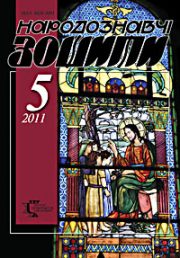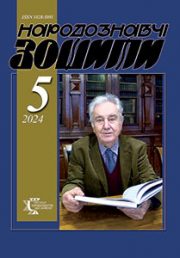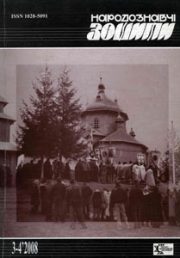The Ethnology Notebooks. 2024. № 4 (178), 955—972
UDK [738:[398:113.2]](=161.2)
DOI https://doi.org/10.15407/nz2024.04.955
CREATION OF THE WORLD FROM CLAY IN COSMOHONICAL LEGENDS OF UKRAINIANS, AND THEIR SOURCES
RAKHNO Kostyantyn
- ORCID ID: https://orcid.org/0000-0002-0973-3919
- Doctor of History, Associate Professor,
- Leading Researcher of the National Museum
- of Ukrainian Pottery in Opishne,
- 02, Partyzanska Street, 38164, Opishne, Zinkiv District,
- Poltava Region, Ukraine,
- Contacts: e-mail: krakhno@ukr.net
Abstract. The cosmogonic ideas of the Ukrainians and other Slavs can be reconstructed based on numerous texts that existed in different forms: as independent mythological plots and as the beginning of great folklore epics. These texts tell about the events in which the world was created, that is, about the establishment of a cosmic structure instead of the original chaos. One of the first links in the cosmogonic chain was occupied by the earth. In Ukrainian folklore, the raw material was usually clay (rarely sand), and the creative act of higher forces was constantly compared to the work of a potter. The purpose of this article is to investigate the origins of the Ukrainian versions of the dualistic cosmogonic narrative and their connections with the stories of other Slavic peoples. The object of the study is the Ukrainian reflexes of Indo-European mythology preserved in cosmogonic legends. According to Ukrainian folk beliefs, many of which have analogies in ancient myths and medieval dualistic legends, the earth and sky were created by God with the active assistance of the Devil, his companion, from clay extracted from the seabed. At the same time, the substance for creation always brings the Devil. Such options are very archaic, because they consider the Devil, the inhabitant of the chthonic bottom, as an almost equal partner of God in the process of creating the world and can give them both certain pre-Christian characteristics. These are the heirs of the pagan Belobog and Chernobog. The methodological basis of the research is the structuralist methodological toolkit.
The basis of the work is folklore materials that show the antiquity of cosmogonic ideas of Ukrainians, close, in particular, to similar ideas of the southern Slavs. The results of the research are that they highlight the antiquity of Ukrainian cosmogonic legends, their commonality with ancient Iranian and Indo-Aryan myths, including the Vedic ones, together with the motif of diving for clay to the bottom of the primordial sea. In Ukrainian folklore, as among the South Slavs, the creation of the world was viewed through the prism of pottery. This was due to the high status of the potter and pottery in the traditional culture of these peoples.
Keywords: cosmogonic myths, cosmogonic legends, clay, pottery, pottery, Indo-Aryan mythology, Iranian mythology, Slavic mythology.
Received 29.07.2024
REFERENCES
- Danilevsky, G. (1888). The Story of the Lord and the Land. (Towards Memories of Gogol). Historical Bulletin, 34, 12, 730—736 [іn Russian].
- Angelovska-Panova, M. (2004) Bogomilism in Spiritual Culture in Macedonia. Skopje and Prilep: Az-Buki; Institute for Old Slavic Culture [іn Bulgarian].
- Tomicki, R. (1976). The Slavic Cosmogonic Myth. Polish Ethnography, XX, 1, 48—97 [іn Polish].
- Erben, K.J. (1866). Slavic Myths about the Creation of the World. Journal of the Museum of the Kingdom of the Czech Republic (14th year, vol. 1, pp. 35—45). Prague: published by the Museum of the Czech Kingdom [іn Czech].
- Afanasyev, A.N. (1868). Poetic Views of the Slavs on Nature: An Attempt at a Comparative Study of Slavic Legends and Beliefs, in Connection with the Mythical Tales of other Related Peoples (vol. 2). Moscow: published by K. Soldatenkov [іn Russian].
- Kvashnin-Samarin N. (1872). An Essay on Slavic Mythology. Beseda, 4, 219—268 [іn Russian].
- Veselovskiy, A. (1872). Slavic Tales about Solomon and Kitovras and Western Legends about Morolf and Merlin. St. Petersburg: typography by V. Demokov [іn Russian].
- Veselovskiy, A.N. (1889). Research in the Field of Russian Spiritual Verse. XI—XVII (issue 5). St. Petersburg: Printing House of the Imperial Academy of Sciences [іn Russian].
- Veselovskiy, A. (1890). On the Question of Dualistic Cosmogonies. Ethnographic Review, 2, 32—48 [іn Russian].
- Shchapov, A.P. (1906). Works in 3 Volumes (with a Portrait) (Vol. 1). St. Petersburg: published by M.V. Pirozhkov [іn Russian].
- Barsov, E. (1886). Folk Legends about the Creation of the World: to the «Tale of the Sea of Tiberias». Readings at the Imperial Society of Russian History and Antiquities at Moscow University (Book 4, part IV, pp. 1—7). Moscow: University Printing House [іn Russian].
- Veckenstedt E. (1889). The Cosmogonies of the Aryans. Journal of Ethnology in Legends and Fairy Tales, Anecdotes and Pranks, Songs, Riddles and Proverbs, Customs and Traditions, II, 1—16 [іn German].
- Dragomanov, M. (1907). Mykhailo Dragomanov’s Studies on Ukrainian Folklore and Literature (vol. IV). Lviv: Shevchenko Scientific Society’s publishing house [іn Ukrainian].
- Bulashev, G.O. (1909). Ukrainian People in Their Legends and Religious views and Beliefs. First issue. Cosmogonic Ukrainian Folk Views and Beliefs. Kyiv: Printing House of the Imperial University of St. Vladimir joint-stock company by N.T. Korchak-Novitsky [іn Russian].
- Korobka, N. (1909). The Image of a Bird Creating the World in Russian Folklore and Writing. Proceedings of the Department of Russian Language and Literature of the Imperial Academy of Sciences (Vol. XIV, book 4, pp. 175—195). St. Petersburg: Printing house of the Imperial Academy of Sciences [іn Russian].
- Radchenko, K.F. (1910). Studies on Bogomilism. Folk Cosmogonic Legends of the Slavs in Their Attitude to Bogomilism. Introduction. I—II. Proceedings of the Department of Russian Language and Literature of the Imperial Academy of Sciences (Vol. XV, book 4, pp. 73—131. St. Petersburg: Printing House of the Imperial Academy of Sciences [іn Russian].
- Dahnhardt, O. (1907). Legends about Nature (Vol. I) Legends of the Old Testament. Leipzig and Berlin: Printed and published by B.G. Teubner [іn German].
- Markov, A.V. (1913). The Sea of Tiberias in the Dualistic Legend of the Creation of the World. Ethnographic Review, 1— 2, 64—75 [іn Russian].
- Hrushevsky, M.S. (1994). History of Ukrainian Literature: in 6 volumes, 9 books (vol. IV). Kyiv: Lybid [іn Ukrainian].
- Belyaev, M.V. (1925). Origin of Folk Legends about the Creation of the World. Bulletin of the V.I. Lenin Azerbaijan State University (Vol. 4—5, pp. 66—74), Baku [іn Russian].
- Sosenko, K. (1928). Cultural and Historical Figure of the Old Ukrainian Festivals of Christmas and Epiphany Eve. Lviv: published by the author [іn Ukrainian].
- Zolotarev, A.M. (1964). Tribal System and Primitive Mythology. Moscow: Nauka [іn Russian].
- Count, E.W. (1935). The Earth-Diver: An Attempt at an Asiatic-American Correlation. Berkeley: University of California.
- Bianchi, U. (1983). Religious Dualism: a Historical and Ethnological Essay. Rome: Edizioni dell’Ateneo [іn Italian].
- Rogov, A.I. (1988). Cultural Ties Between Kievan Rus and Other Slavic Countries During Its Christianization. The Adoption of Christianity by the Peoples of Central and Southeastern Europe and the Baptism of Rus (Pp. 207—234). Moscow: Nauka.
- Ivanov, J. (1970). Bogomil Books and Legends. Sofia: Nauka i izkustvo [іn Bulgarian].
- Angelov, D. (1954). Bogomilism in Bulgaria. Moscow: Foreign Literature Publishing House [іn Russian].
- Laszlo-Kutsyuk, M. (1992). Fire and the Word: Cosmogonic Myth in Ukraine. Bucharest: Criterion [іn Ukrainian].
- Sokil, V. (1995). Folk Legends and Traditions of the Ukrainians of the Carpathians. Kyiv: Naukova Dumka [іn Ukrainian].
- Chausidis, N. (2003). Dualistic Images: Bogomilism in the Medium of the Image. Skopje: List [іn Macedonian].
- Eliade M. (1995). From Zalmoxis to Genghis Khan: Comparative Studies in the Religions and Folklore of Dacia and Eastern Europe. Bucharest: Humanitas [іn Romanian].
- Porfiryev, I. (1877). Apocryphal Tales about Old Testament Figures and events Based on the Manuscripts of the Solovki Library. St. Petersburg: Printing House of the Imperial Academy of Sciences [іn Russian].
- Sumtsov, N.F. (1888). Essays on the History of Southern Ruthenian Apocryphal Tales and Songs. Kiev: Printing House of A. Davidenko [іn Russian].
- Georgieva, I. (1983). Bulgarian Folk Mythology. Sofia: Science and Art [іn Bulgarian].
- Boneva T. (1994). Folk World-View. Rhodopi. Traditional Folk Spiritual and Socionormative Culture (pp. 7—50). Sofia: Ethnographic Institute with Museum –— BAS [іn Bulgarian].
- Kolberg, O. (1888). Pokuttya. Ethnographic Image (Vol. ІII). Cracow: Jagiellonian University Printing House [іn Polish].
- Shukhevych, V. (1908). Hutsul Region (vol. 5). Lviv: General Printing House [іn Ukrainian].
- Schnaider, J. (1900). From the Land of the Hutsuls. People, VI, 157—160, 257—267, 351—361 [іn Polish].
- Onyshchuk, A. (1909). Materials for Hutsul Demonology. Recorded in Zelenytsia, Nadvirna County, 1907—1908. Materials for Ukrainian Ethnology (Vol. XI, pp. 1—139). Lviv: Shevchenko Scientific Society printing house [іn Ukrainian].
- Kotsyubynskyi, M. (1974). Works in seven volumes. Vol. 3. Stories, short stories (1908—1913). Kyiv: Naukova dumka [іn Ukrainian].
- Mushynka, M. (1987). Volodymyr Hnatiuk: Life and His Activities in the Field of Folkloristics, Literary Studies and Linguistics. Notes of the Shevchenko Scientific Society. Paris; New York; Sydney; Toronto: without typograhy [іn Ukrainian].
- Hnatiuk, V. (1902). Galician-Ruthenian Folk Legends. Vol. I. Ethnographic collection. Published by the Ethnographic Commission of the Shevchenko Scientific Society (Vol. XII). Lviv: Shevchenko Scientific Society printing house [іn Ukrainian].
- Kuznetsova, V.S. (1998). Dualistic Legends about the Creation of the World in the East Slavic Folklore Tradition. Novosibirsk: SB RAS Publishing House, Geo Branch [іn Russian].
- Kuznetsova V. (1998). The Creation of the World in East Slavic Dualistic Legends and Apocryphal Books. From Genesis to Exodus: Reflection of Biblical Plots in Slavic and Jewish Folk Culture (pp. 59—78). Moscow: Geos [іn Russian].
- Johns, A. (2005). Slavic Creation Narratives: The Sacred and the Comic. Fabula, 46 (3—4), 257—291.
- Koenig, S. (1936). Cosmogonic Beliefs of the Hutsuls. Folk-Lore, 47, 4, 368—373.
- Pankevich, I. (1938). Ukrainian Dialects of Subcarpathian Rus and Adjacent Regions. Attached are 5 dialectical maps. Part 1. Sound and morphology. Prague: at the expense of the Research Council of Slovakia and Subcarpathian Rus; in the commission of the publishing house «Orbis» — the press of Politics in Prague [іn Ukrainian].
- Gustawicz, B. (1902). Some Folkloric Details from the Bуbrka District. People, VIII, 265—274 [іn Polish].
- Pomerantseva, E.V. (1975). Mythological Characters in Russian Folklore. Moscow: Nauka [іn Russian].
- Lafazanovski, E. (2000). Macedonian Cosmogonical Legends. Skopje: Culture; Marko Tsepenkov Institute for Folklore [іn Macedonian].
- Popov, R., Mitseva, E. (2002). People’s World-View. Sakar: Ethnographic, Folklore and Lingual Studies (Pp. 231—254). Sofia: academic publishing house “prof. Marin Drinov” [іn Bulgarian].
- Chausidis N., Nikolov G. (2006). Tsrepna and Vrshnik: Mythological-semiotic analysis. Studia mythologica slavica, IX, 97—160 [іn Macedonian].
- Tsepenkov, M.K. (1972). Macedonian Folklore Works in Ten Books. Book 7. Legends. Skopje: Macedonian Book [іn Macedonian].
- Benovska-Sabkova, M. (1992). The Snake in Bulgarian Folklore. Sofia: Bulgarian Academy Publishing House on Science [іn Bulgarian].
- (1999). Rigveda. Mandalas IX—X. Moscow: Nauka [іn Russian].
- Chubinskiy, P.P. (1872). Works of the Ethnographic and Statistical Expedition to the Western Russian Region, Equipped by the Imperial Russian Geographical Society. Vol. 1. Beliefs and Superstitions. Riddles and Proverbs. Witchcraft. St. Petersburg: V. Bezobrazov Printing House, XXX, 467 p. [іn Russian].
- Tereshchenkova, S. (1928). Beliefs about the Sun (Zvenyhorodka District in Kiev Region). Ethnographic Bulletin, 7, 133—137 [іn Ukrainian].
- Kulishic, Sh., Petrovic, P.Zh., Pantelic, N. (1970). Serbian Mythological Dictionary. Beograd: Nolit [іn Serbian].
- Tatarovska L.K. (2006). Metamorphoses in Macedonian Folklore: Metaphysics on Syncretism. Skopje: Menorah [іn Macedonian].
- Latvian Folk Legends. Selected Ones (1962). Compiled by A. Ancelane. Riga: Publishing House of the Academy of Sciences of the Latvian SSR [іn Russian].
- Gasanov, B. (2022). Chernobog — the Dark Force of the Slavic Pantheon. Sources. Formation of the Image. Moscow: TH Veligor [іn Russian].
- (1971). Fairy Tales of Central India. Translated from English and Santal by G.A. Zograf and Z.E. Samoilova. Preface and notes by G.A. Zograf. Moscow: Nauka [іn Russian].
- Russell, R.V. (1916). The Tribes and Castes of the Central Provinces of India (vol. III). London: MacMillan and Co. Limited.
- Vassilkov, Ya.V. (2006). A Page from a Mythological Bestiary: A Shaking Boar. The Culture of Arabia in the Asian Context (Pp. 250—262). St. Petersburg: Petersburg Oriental Studies.
- Vassilkov, Y. (2006). The Boar Shakes the Mud off: A Specific Motif in the Varāhakathā of the Great Epic and Purāṇas. Battles, Bards, Brāhmans: Papers from the Epics Section of the 13th World Sanskrit Conference. Edinburgh, 10th—14th July 2006 (pp. 301—432). Delhi: Motilal Banarsidass Publishers Private Limited.
- (1900). The Satapatha-Brahmaṇa according to the text of the Madhyandina School. Part V. Books XI, XII, XIII, and XIV. Translated by J. Eggeling. Oxford: The Clarendon Press.
- Leeming, D.A. (2009). Creation Myths of the World: An Encyclopedia. Santa Barbara; Denver; Oxford: ABC—CLIO.
- Visnu Purana (1995). Translation from Sanskrit, commentary, introduction by T.K. Posova. St. Petersburg: Vedic Culture Society.
- Gonda, J. (1969). Aspects of Early Viṣṇuism. Delhi; Varanasi; Patna: Motilal Banarsidass.
- A Prose English Translation of Harivamsha (1897). Edited and Published by Manmatha Nath Dutt. Calcutta: Printed by H. C. Dass, Elysium Press.
- (1989). Rigveda Mandalas I —IV. Moscow: Nauka [іn Russian].
- Charpentier, J. (1911). Small Contributions to Indo-Iranian Mythology. Uppsala: Academic Printing Office [іn German].
- Gonda, J. (1986). Prajapati’s Rise to Higher Rank. Leiden: E.J. Brill.
- Prasad, M. (1989). Some Aspects of the Varaha-Katha in Epics and Puranas. Delhi: Pratibha Prakashan.
- Kuiper, F.B.J. (1950). An Austro-Asiatic Myth in the Rigveda. Proceedings of the Royal Netherlands Academy of Arts and Sciences, N.S. (Deel 13, 7, 163—182. Amsterdam: N. V. North Holland Publishing Company.
- Dange, S.A. (1996). Towards Understanding Hindu Myths. New Delhi: Aryan Books International.
- Bhattacharya, G. (1999). Viṣṇu Assuming the Boar Form. Oriental Art, XLV, 3, 44—47.
- Rigveda. Mandalas V—VIII. (1995). Moscow: Science [іn Russian].
- Nagar, Sh.L. (1993). Varāha in Indian Art, Culture, and Literature. New Delhi: Aryan Books International.
- Mayrhofer, M. (1956). Concise Etymological Dictionary of Ancient Indian. Vol. 1. A-Th. Heidelberg: Carl Winter University Publishing House [іn German].
- Witzel M. (1999). Substrate Languages in Old Indo-Aryan (Rgvedic, Middle and Late Vedic). Electronic Journal of Vedic Studies, 5, 1, 1—67.
- Benveniste, E., Renou, L. (1934). Vṛtra and Vṛиragna: Study of Indo-Iranian Mythology. Paris: National Printing [іn French].
- Grassmann, H. (1873). Dictionary of the Rigveda. Leipzig: F.A. Brockhaus [іn German].
- Elwin, V. (1950). Bondo Highlander. London: Oxford University Press.
- Elwin, V. (1949). Myths of Middle India. Madras: Oxford University Press.
- Elwin, V. (1954). Tribal Myths of Orissa. Bombay: Oxford University Press.
- Parker, H. (1910). Village Folk Tales of Ceylon (vol. 1). London: Luzac & Co.
- (1985). nhalese Tales. Compiled, translated from Sinhalese and English, and annotated by B.M. Volkhonsky and O.M. Solntseva. Preface by O.M. Solntseva. Moscow: Nauka [іn Russian].
- (1950). Mahabharata. Book One. Adiparva. Translated from Sanskrit and commented by V.I. Kalyanov. Leningrad: Nauka [іn Russian].
- Razauskas, D. (2005). The Retra Sea Boar in Light of Baltic-Slavic Tales about the «Fish Shepherd». Baltic Crossroads. Ethnos. Confession. Myth. Text (Pp. 254—267). St. Petersburg: Nauka [іn Russian].
- (2009.). Thietmar of Merseburg. Chronicle. In 8 books. Translated from Latin by I.V. Dyakonova. Moscow: Russkaya Panorama [іn Russian].
- Kuhn, A., & Schwartz, W. (1848). North German Legends, Fairy Tales and Customs from Mecklenburg, Pomerania, the Mark, Saxony, Thuringia, Brunswick, Hanover, Oldenburg and Westphalia, Collected and Published from the Mouths of the People. Leipzig: F.A. Brockhaus [іn German].
- Graves, R. 1992. The Greek Myths. Moscow: Progress [in Russian].
- Darchiev, A.V. (2004). Elements of Archaic Myth in the Tale of Batraz’s Fight with the Wild Boar. Rhythms of History (Issue 2.1, pp. 199—245). Vladikavkaz: NOHU Publishing House [іn Russian].
- Avesta in Russian Translations (1861—1996) (1997). Compilation, general editing, notes, and reference section by I. V. Rak. St. Petersburg: Neva Magazine – RHSI [іn Russian].
- Avesta (2005). An Experiment in Morphological Transcription and Translation by V. S. Sokolova, Preparation of Materials for Publication and Editing by I.A. Smirnova. St. Petersburg: Nauka [іn Russian].
- Firdausi. (1965). Shahnameh. Vol. 3. From the Legend of the Battle of Rostem with the Khakan of China to the Reign of Lohrasp. Translation by N.B. Banu-Lahuti, commentaries by A. Azer and Ts.B. Banu-Lahuti. Moscow: Nauka [іn Russian].
- Darmesteter, J. (1883). Iranian Studies. Part One. Iranian Miscellany (Vol. 2).Paris: F. Vieweg [іn French].






